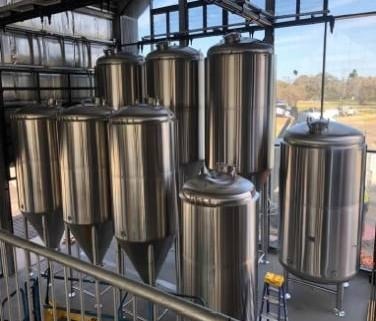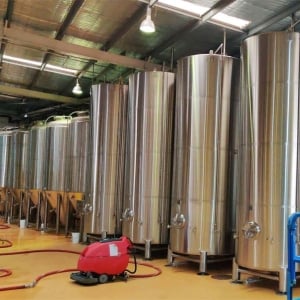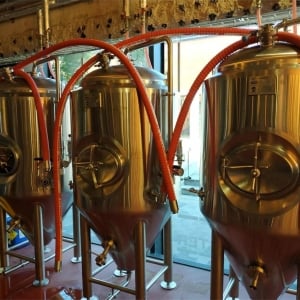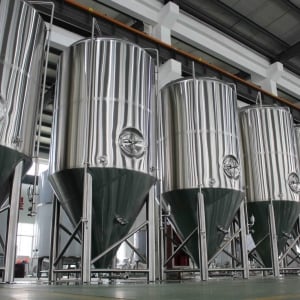Large Fermentation Tanks
Large fermentation tanks, also known as unitanks or fermenters, are the workhorses of commercial breweries, wineries, and distilleries. These colossal vessels are responsible for transforming wort (unfermented beer), grape must, or other fermentable liquids into their final alcoholic or non-alcoholic products.
Imagine towering cylinders, gleaming stainless steel giants, meticulously engineered to provide the ideal environment for the delicate dance of yeast and sugar. Inside these behemoths, magic happens – the science of fermentation unfolds, yielding the delightful beverages we enjoy.
Let’s delve deeper into the world of large fermentation tanks, exploring their functionalities, types, applications, and the nitty-gritty aspects like choosing the right supplier and navigating installation, operation, and maintenance.
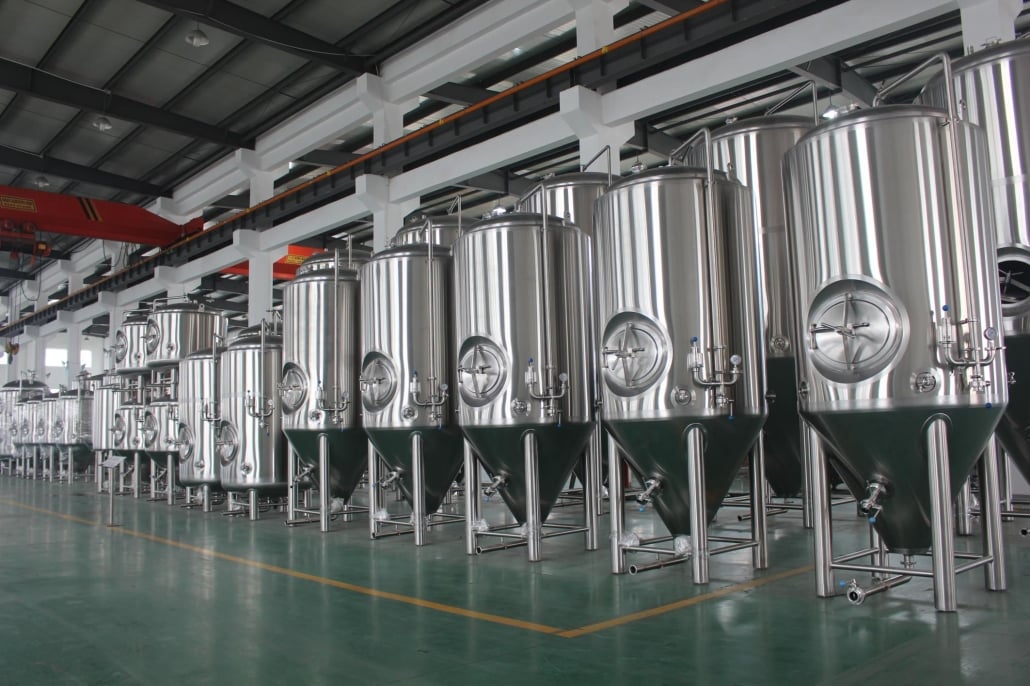
Features of Large Fermentation Tanks:
| Feature | Description |
|---|---|
| Material | Typically high-grade stainless steel (SS304 or SS316) for durability, hygiene, and ease of cleaning. |
| Capacity | Ranging from hundreds to thousands of gallons, catering to various production volumes. |
| Shape | Primarily cylindrical with conical bottoms (conical tanks) for optimal yeast collection and easier cleaning. Flat-bottomed tanks are also used but require additional yeast harvesting procedures. |
| Jacketing | Jacketed tanks have a double wall that allows for the circulation of a coolant (glycol) or heating medium for precise temperature control during fermentation. |
| Insulation | Insulated tanks further enhance temperature control and minimize energy consumption. |
| Valves and Fittings | Equipped with valves for sampling, transferring product, introducing CO2 pressure, and managing yeast sediment. |
| Cleaning Systems | Often incorporate Cleaning-In-Place (CIP) systems for automated cleaning and sanitation. |
| Safety Features | Include pressure relief valves, manways for access, and level indicators for safe operation. |
Types of Large Fermentation Tanks:
| Type | Description | Applications |
|---|---|---|
| Conical Tanks | The most common type, with a cone-shaped bottom that facilitates yeast collection and cleaner racking (transferring clarified beverage). | Beer, wine, cider, kombucha, and other beverages. |
| Brite Tanks | Used for final conditioning, filtering, and carbonation of beer before packaging. | Beer production. |
| Horizontal Tanks | Less common due to space constraints, but offer advantages like easier access for cleaning and potential space savings in specific layouts. | Wineries and cideries sometimes utilize horizontal tanks for fermentation or storage. |
The Brewing Process with Large Fermentation Tanks
The brewing process involving large fermentation tanks can be summarized in these key stages:
- Filling: The sterilized tank is filled with wort, transferred from the brewhouse after boiling and hopping.
- Pitching Yeast: A specific yeast strain is introduced into the wort to initiate fermentation.
- Fermentation: Yeast consumes sugars in the wort, producing alcohol and CO2. Temperature control is crucial during this stage, impacting flavor profiles and fermentation efficiency. Jacketed tanks excel at maintaining consistent temperatures.
- Maturation (Secondary Fermentation): After primary fermentation, the beer may undergo a secondary fermentation in the tank or be transferred to another tank for further conditioning. This allows flavors to mature and harmonize.
- Yeast Harvesting: In conical tanks, the conical bottom allows for easier collection of spent yeast after fermentation.
- Transfer and Packaging: The finished beer is then transferred to conditioning tanks, filtration equipment, and eventually, kegs or bottles for packaging.
Capacity, Space Considerations, Design, Layout, and Customization
| Factor | Description | Considerations |
|---|---|---|
| Capacity | Select a tank size that aligns with your production volume and batch sizes. Consider future expansion plans when making this decision. | |
| Space | Factor in the footprint of the tanks, including headspace for foam during fermentation and clearance for ladders and walkways for safe operation. | Utilize space planning software or consult an experienced brewery engineer to optimize tank layout within your facility. |
| Design | Conical tanks offer several advantages, but flat-bottomed tanks might be suitable for specific applications or space constraints. | |
| Layout | Plan the tank layout to ensure efficient workflow, considering gravity flow for transfers whenever possible. Maximize space utilization while prioritizing safety and accessibility. | Brewery design consultants can assist with creating an optimal tank layout for your specific needs. |
| Customization | Some manufacturers offer customization options such as specific port locations, additional valves, integrated CIP systems, and specialized finishes |
Large Fermentation Tanks: Price Range
Large fermentation tanks are a significant investment for any brewery, winery, or distillery. Understanding the price range will help you budget effectively and make informed purchasing decisions. Here’s a breakdown of factors influencing their cost:
- Size (Capacity): Unsurprisingly, larger tanks with higher capacities command a higher price tag. Prices typically start around $3,000 for small (50-gallon) plastic tanks suitable for homebrewing or small-scale kombucha production. Stainless steel tanks for commercial applications begin around $5,000 for a basic 1-barrel (31-gallon) unit. As you move into larger production volumes (hundreds to thousands of gallons), prices can escalate quickly, reaching well over $100,000 for behemoth tanks used in large-scale breweries.
- Features: The more bells and whistles, the steeper the price curve. Jacketed tanks with glycol cooling systems will cost more compared to non-jacketed tanks. Similarly, features like integrated CIP systems, additional ports and valves, and specialized finishes will add to the overall cost.
- Material: High-grade stainless steel (SS304 or SS316) is the industry standard for its durability, hygiene, and ease of cleaning. However, some manufacturers might offer less expensive options using lower-grade stainless steel, although this can impact longevity and sanitation practices.
- Manufacturer and Location: Prices can vary depending on the manufacturer’s reputation, brand recognition, and geographic location. Established brands with a proven track record might command a premium compared to lesser-known manufacturers. Additionally, tanks manufactured overseas (e.g., China) may be offered at a lower price point due to varying production costs. However, factors like shipping costs, import duties, and potential warranty limitations should be considered when exploring overseas options.
Here’s a table summarizing the typical price range for large fermentation tanks:
| Capacity | Jacketed | Non-jacketed |
|---|---|---|
| 1 Barrel (31 gallons) | $5,000 – $10,000 | $3,000 – $7,000 |
| 10 Barrels (310 gallons) | $15,000 – $30,000 | $10,000 – $20,000 |
| 100 Barrels (3,100 gallons) | $50,000 – $100,000 | $30,000 – $70,000 |
| 500 Barrels (15,500 gallons) | + $100,000 | + $70,000 |
Remember: These are ballpark figures. For the most accurate pricing, it’s crucial to contact potential suppliers and request quotes based on your specific needs and desired features.
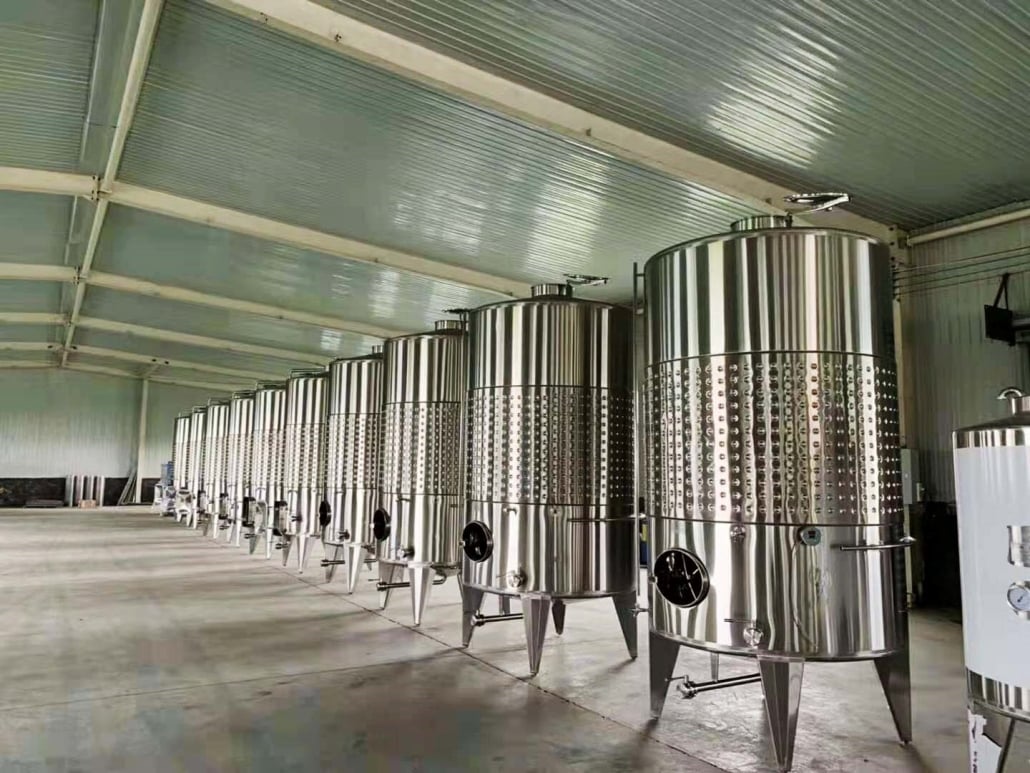
Suppliers of Large Fermentation Tanks
The market offers a diverse range of suppliers for large fermentation tanks. Here are some factors to consider when choosing a supplier:
- Reputation and Experience: Opt for a reputable supplier with a proven track record in manufacturing high-quality fermentation tanks. Look for companies with experience catering to your specific industry (brewing, winemaking, etc.).
- Product Range and Customization Options: Does the supplier offer a variety of tank sizes and configurations to suit your needs? Do they provide customization options to cater to your specific requirements?
- Quality Standards and Certifications: Ensure the supplier adheres to strict quality standards and uses food-grade materials for tank construction. Look for certifications like ASME (American Society of Mechanical Engineers) for pressure vessel safety.
- Customer Service and Warranty: Reliable customer service is essential for post-purchase support and troubleshooting. Inquire about warranty coverage and the supplier’s response timeframe for any service needs.
- Lead Time and Shipping: Consider the lead time for tank fabrication and delivery, especially if you have specific production timelines to meet. Factor in shipping costs and potential delays associated with overseas suppliers.
Here’s a table listing some prominent suppliers of large fermentation tanks, categorized by region:
| Region | Suppliers |
|---|---|
| North America | * Speidel * Brewmation * Yakima Valley Brewing * Midland * Ss Brewtech |
| Europe | * Stalgast * Ahlborn * Deutsche Process * INOXFERM * Paul Jaegers |
| Asia | * YMC * King Steel * Krones * Jiaozuo * Tianfang |
Installation, Operation, and Maintenance of Large Fermentation Tanks
- Installation: Large fermentation tanks are heavy equipment, and proper installation is crucial for safety and functionality. Here’s a general overview of the installation process:
- Site preparation: Ensure the designated area for the tanks has a level, solid foundation capable of supporting the weight of the filled tank. Consider plumbing and electrical needs for utilities like glycol cooling and temperature control systems.
- Delivery and Offloading: Specialized equipment like forklifts or cranes might be necessary for safe offloading and maneuvering the tanks into position.
- Positioning and Leveling: Carefully position the tank on its designated base and ensure proper leveling using adjustable feet or pads.
- Connection to Utilities: Connect the tank to utilities like glycol lines, water lines, CO2 lines, and electrical supply for temperature control and other systems.
- Cleaning and Sanitization: Perform a thorough cleaning and sanitization of the tank before its initial use.
- Operation: Operating large fermentation tanks involves several key aspects:
- Pre-fermentation Setup: Prior to filling the tank with wort or must, ensure proper temperature control settings and prepare for yeast pitching.
- Filling and Inoculation: Transfer the wort or must to the tank and introduce the chosen yeast strain at the appropriate temperature.
- Monitoring Fermentation: Continuously monitor fermentation progress, including temperature, pressure, and gravity readings. Adjust temperature settings as needed to maintain optimal conditions for the specific yeast strain and desired beer style.
- Maturation (Secondary Fermentation): After primary fermentation, the beverage might undergo secondary fermentation in the tank or be transferred to another tank for conditioning.
- Yeast Harvesting (Conical Tanks): In conical tanks, after fermentation, collect the spent yeast from the conical bottom for potential reuse or disposal.
- Transfer and Packaging: Once fermentation and conditioning are complete, transfer the finished beverage to conditioning tanks, filtration equipment, and ultimately, kegs or bottles for packaging.
- Cleaning and Sanitization: Meticulously clean and sanitize the tank after each use to prevent contamination and ensure the quality of subsequent batches.
- Maintenance: Regular maintenance is essential to ensure the longevity and optimal performance of large fermentation tanks. Here are some key maintenance practices:
- Cleaning Procedures: Establish a routine cleaning and sanitation schedule based on your production frequency and type of beverage being produced. Utilize recommended cleaning solutions and adhere to proper cleaning protocols.
- Gasket and Seal Maintenance: Regularly inspect gaskets and seals for wear and tear. Replace them promptly to prevent leaks and maintain proper sanitation.
- Calibration of Equipment: Calibrate temperature control systems and other instrumentation periodically to ensure accurate readings and optimal fermentation conditions.
- General Maintenance: Perform visual inspections of the tank for any signs of damage or leaks. Regularly lubricate moving parts and address any minor maintenance issues promptly to prevent them from escalating into bigger problems.
Choosing the Right Supplier for Large Fermentation Tanks
Selecting the right supplier for your large fermentation tanks is a crucial decision. Here’s a table outlining key factors to consider during the selection process:
| Factor | Description |
|---|---|
| Reputation and Experience | Research the supplier’s reputation within the industry. Look for companies with a proven track record of quality and experience catering to your specific industry (brewing, winemaking, etc.). |
| Product Range and Customization Options | Does the supplier offer a variety of tank sizes and configurations to suit your current and potential future needs? Do they provide customization options to address your specific requirements (e.g., port locations, additional valves)? |
| Quality Standards and Certifications | Ensure the supplier adheres to strict quality standards and uses food-grade materials for tank construction. Look for certifications like ASME (American Society of Mechanical Engineers) for pressure vessel safety. |
| Customer Service and Warranty | Reliable customer service is essential for post-purchase support and troubleshooting. Inquire about warranty coverage, response times for service needs, and the availability of spare parts. |
| Lead Time and Shipping | Consider the lead time for tank fabrication and delivery, especially if you have specific production timelines to meet. Factor in shipping costs and potential delays associated with overseas suppliers. |
| Pricing and Payment Terms | Compare pricing from several suppliers while considering the value proposition beyond just the initial cost. Inquire about payment terms and financing options if needed. |
Here are some additional tips for choosing the right supplier:
- Get quotes from multiple suppliers: Don’t settle for the first quote you receive. Obtain quotes from several reputable suppliers to compare pricing, features, and overall value proposition.
- Visit the supplier’s facilities (if possible): If feasible, schedule a visit to the supplier’s manufacturing facility to witness their production process firsthand. This can provide valuable insights into their quality control standards and overall attention to detail.
- Read customer reviews and testimonials: Research online reviews and testimonials from other customers who have purchased tanks from the supplier. This can offer valuable real-world perspectives on the supplier’s products, customer service, and overall experience.
- Ask questions: Don’t hesitate to ask the supplier detailed questions about their products, customization options, warranty coverage, and after-sales support. A responsive and knowledgeable supplier is a good indicator of their commitment to customer satisfaction.
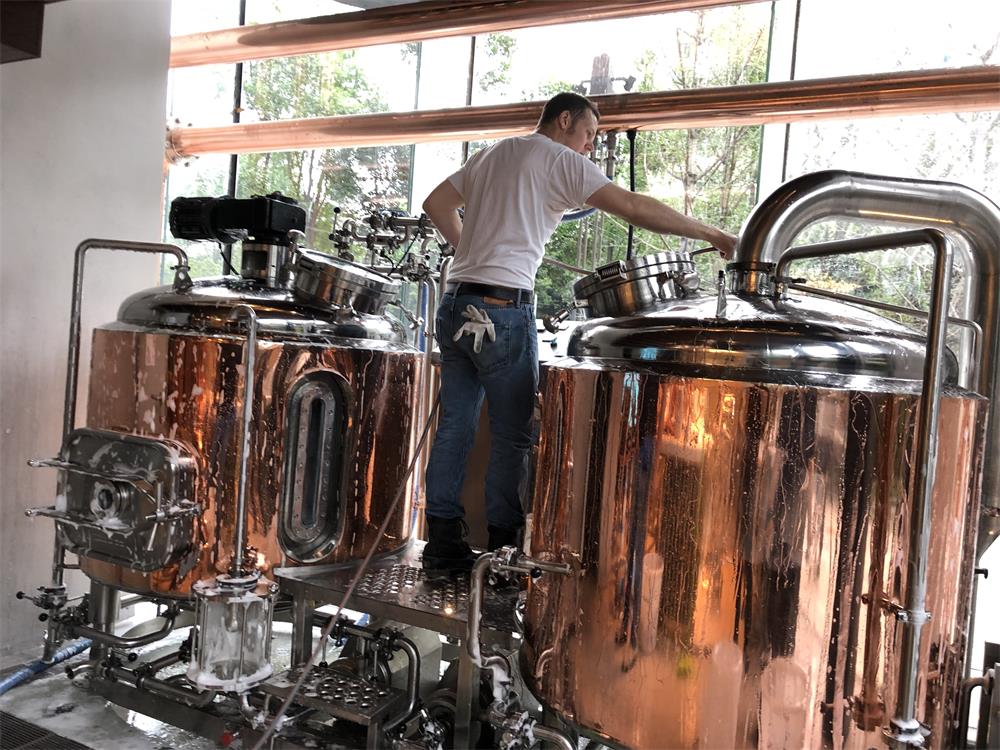
Pros and Cons of Large Fermentation Tanks
Large fermentation tanks offer a multitude of advantages for commercial beverage production, but there are also some limitations to consider. Here’s a breakdown of the pros and cons:
Pros:
- Increased Production Capacity: Large tanks enable breweries, wineries, and distilleries to produce larger volumes of beverages compared to smaller fermenters. This translates to increased efficiency and potential for growth.
- Improved Consistency and Control: Jacketed tanks with temperature control systems allow for precise control over fermentation temperatures, leading to more consistent and predictable final product quality.
- Reduced Labor Costs: Larger tanks can streamline the brewing process, requiring fewer transfers and potentially reducing overall labor costs.
- Scalability: Many large fermentation tank designs offer modularity, allowing breweries to add more tanks as their production needs increase.
- Automation Potential: Large tanks can be integrated with automated control systems for monitoring and adjusting fermentation parameters, further enhancing efficiency and consistency.
Cons:
- High Initial Investment: Large fermentation tanks represent a significant upfront investment compared to smaller-scale equipment. This can be a hurdle for startups or smaller producers.
- Space Requirements: These tanks have a substantial footprint, requiring ample space for installation and operation. Careful planning is necessary to optimize tank layout within your facility.
- Maintenance Needs: Regular cleaning, sanitation, and maintenance are crucial to ensure optimal performance and longevity. This requires dedicated time and resources.
- Less Flexibility (compared to smaller tanks): Large tanks might limit flexibility for experimenting with smaller batch sizes or trying out new recipes. For some breweries, a combination of large and small tanks might be the ideal solution.
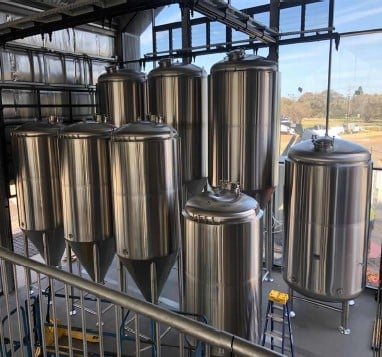
Conclusion
Large fermentation tanks are the workhorses of commercial beverage production. Understanding their functionalities, types, and considerations for choosing the right supplier empowers you to make informed decisions for your brewery, winery, or distillery. By carefully weighing the pros and cons, and selecting a reputable supplier that aligns with your needs, you can leverage these powerful tanks to achieve your production goals and deliver high-quality beverages to your customers.
FAQ
Q: What is the difference between a conical tank and a brite tank?
A: Conical tanks have a cone-shaped bottom that facilitates yeast collection and cleaner racking (transferring clarified beverage). They are often used for primary fermentation and conditioning. Brite tanks, on the other hand, are typically cylindrical with flat bottoms and are used for final conditioning, filtering, and carbonation of beer before packaging.
Q: Can I use a plastic tank for fermentation?
A: Small-scale homebrewers might utilize plastic fermenters for cost-effectiveness. However, for commercial production, stainless steel is the industry standard due to its durability, hygiene, and ease of cleaning. Plastic tanks can be susceptible to scratches and harbor bacteria, posing sanitation challenges for large-scale production.
Q: How long do large fermentation tanks last?
A: Well-maintained stainless steel tanks can last for decades with proper cleaning, maintenance, and occasional replacement of parts like gaskets and seals.
Q: Do I need a permit to install a large fermentation tank?
A: Permitting requirements can vary depending on your location and the size of the tank. It’s advisable to check with your local authorities to determine any necessary permits for installing large fermentation tanks. Additionally, adhering to building codes and safety regulations is crucial.

